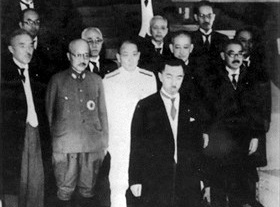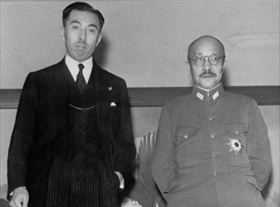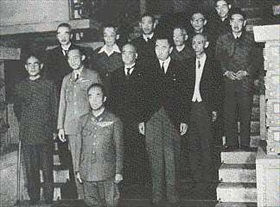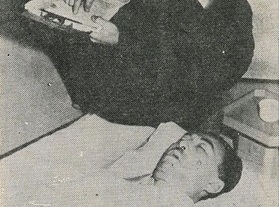TŌJŌ TO REPLACE JAPANESE P.M. KONOE?
Tokyo, Japan · October 16, 1941
On this date in 1941 Prince Fumimaro Konoe resigned as prime minister of Japan. Konoe had lost the support of cabinet and Army minister Gen. Hideki Tōjō, who called for a firmer line with the administration of President Franklin D. Roosevelt over the U.S. ban on the export of scrap metal and the total embargo of oil and gasoline exports to Japan. Over 80 percent of the island nation’s petroleum needs were met through American imports, and the squeeze measures reflected U.S. disgust with the aggressive expansion of Japan into China and Southeast Asia. The month before, on September 6, the Imperial Conference (Gozen Kaigi), a body of civilian and military leaders who met with Emperor Hirohito (posthumously referred to as Emperor Shōwa) to obtain final approval for specific courses of action, had fixed an early October deadline for diplomatically resolving the Japanese-American crisis. If negotiations proved unsatisfactory by mid-October, Japan would commence hostilities against the United States, the Netherlands, and Great Britain, all states with substantial territorial and mineral holdings in Japan’s overseas backyard. On October 14, the deadline came and went. Prime Minister Konoe’s olive branch to Washington—withdrawing Japanese troops from China to improve relations—split his cabinet down the civilian-military fault line. Tōjō argued in favor of vastly expanding the grueling war with China—the Second Sino-Japanese War, which Japan had launched in mid-1937. He postulated that a withdrawal from conquered Chinese territory and the Japanese protectorate of French Indochina, declared on July 25, 1941, to Roosevelt’s enormous chagrin, would undo the gains of the past four years and endanger Japanese control of its Manchurian puppet state, Manchukuo (seized in 1931), and its Korean protectorate (declared in 1910). The next day, October 17, Tōjō assumed the post of prime minister at the head of a thoroughly military-dominated government. Early the next month, on November 3, U.S. Ambassador to Tokyo Joseph Grew cabled Washington that Japan “might resort with dangerous and dramatic suddenness to measures that might make inevitable war with the United States.” That same day Japan’s military command, with Hirohito’s consent, approved Adm. Isoroku Yamamoto’s planned attack on the U.S. naval base at Pearl Harbor, Hawaii.
[amazon_carousel widget_type=”ASINList” width=”600″ height=”200″ title=”Recommended Reading” market_place=”US” shuffle_products=”False” show_border=”False” asin=”0307594017,0060931302,0520219341,082481925X,0870119796,0812968581,0393320278,0823224724,161200010X,0195061683″ /]
Japanese Prime Minister Fumimaro Konoe, 1891–1945
 |  |
Left: Cabinet ministers in Fumimaro Konoe’s second cabinet (July 22, 1940, to October 18, 1941). In this photo taken on inauguration day, war minister and future prime minister Gen. Hideki Tōjō (1884–1948) is second from left in the second row. Konoe resigned seven weeks before the attack on Pearl Harbor when he lost the political support of both the army and navy service branches in their headlong rush to war with the U.S., Great Britain, and the Netherlands.
![]()
Right: On July 22, 1940, Tōjō was appointed Army minister in the second Konoe cabinet and remained in that post in the third (back-to-back) Konoe cabinet. Years earlier, between 1932 and 1934, the scrawny, owlish Tōjō had commanded the Kwantung Army, the largest and most prestigious command in the Imperial Japanese Army. The army was largely responsible for the creation of the Japanese puppet state of Manchukuo in northeast China. Politically, Tōjō was a fascist, nationalist, and militarist, and was nicknamed “Razor” for his reputation for a sharp, legalistic mind capable of making quick decisions.
 |  |
Left: As prime minister in the lead-up to Japan entering World War II, Konoe also played a role in the lead-up to Prime Minister Tōjō’s resignation in July 1944, after the Americans captured the island of Saipan in the Marianas. The next year Konoe served in the first postwar cabinet of Prince Naruhiko Higashikuni (shown here in this newspaper photograph) from August 17 to October 9, 1945. Konoe is the fourth person on the right in the second row.
![]()
Right: A coroner from the American occupation force in Japan performs a postmortem on Konoe on December 17, 1945. Konoe had refused to collaborate with Gen. Douglas MacArthur and the American occupation force in their efforts (Operation Blacklist) to exonerate Emperor Hirohito and the imperial family of criminal responsibility leading up to and during the Asia Pacific War. Konoe thus came under suspicion of war crimes himself. In December 1945, during the last call by U.S. authorities for alleged war criminals to turn themselves in, he committed suicide on December 16, 1945.
Silent News Clips From 1930s and 40s of Emperor Hirohito
![]()

 History buffs, there is good news! The Daily Chronicles of World War II is now available as an ebook for $4.99 on Amazon.com. Containing a year’s worth of dated entries from this website, the ebook brings the story of this tumultuous era to life in a compelling, authoritative, and succinct manner. Featuring inventive navigation aids, the ebook enables readers to instantly move forward or backward by month and date to different dated entries. Simple and elegant! Click
History buffs, there is good news! The Daily Chronicles of World War II is now available as an ebook for $4.99 on Amazon.com. Containing a year’s worth of dated entries from this website, the ebook brings the story of this tumultuous era to life in a compelling, authoritative, and succinct manner. Featuring inventive navigation aids, the ebook enables readers to instantly move forward or backward by month and date to different dated entries. Simple and elegant! Click 











